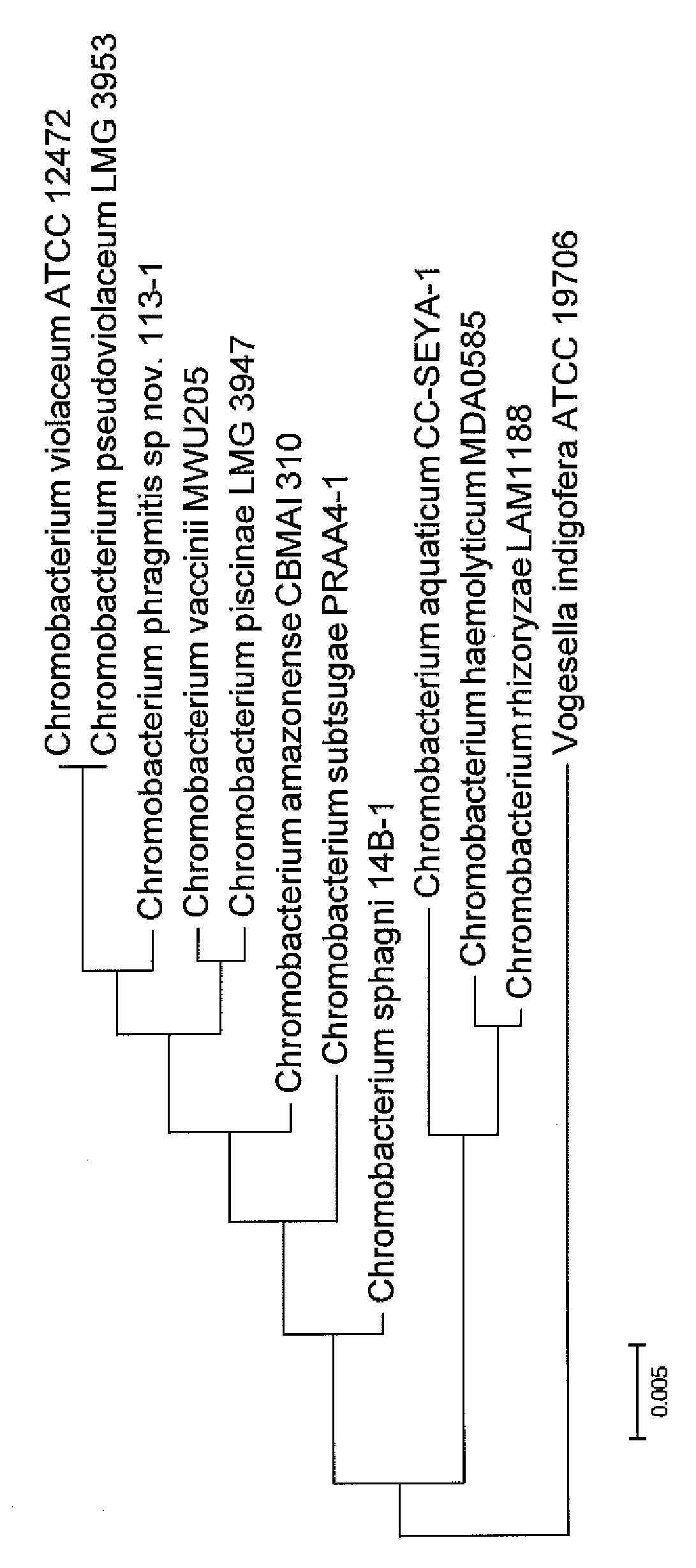Chromobacterium species with insecticidal activity
a chromobacterium and insecticidal technology, applied in the field of new chromobacterium species, can solve the problems of reducing the economic damage of crops, destroying many different types of crops, and affecting the survival of crops, so as to reduce the population of insect larvae
- Summary
- Abstract
- Description
- Claims
- Application Information
AI Technical Summary
Benefits of technology
Problems solved by technology
Method used
Image
Examples
example 1
of Bacteria
[0035]A new strain of Chromobacterium phragmitis sp. nov. that fulfills the criteria for a new species, strain 113-1 (NRRL B-67133), has been obtained. C. phragmitis sp. nov. strain 113-1 (NRRL B-67133) was isolated from a tidal marsh along the Potomac River in Charles County, Md.
[0036]Bacteria are isolated from water samples using a solid medium, modified from Keeble and Cross (J. App. Microbio. 43:2 325-327 (1977)), containing 1 g yeast extract, 3 g nutrient broth, 10 g glucose, 18 g agar, and 50 mg each of the antibiotics neomycin and cycloheximide per liter of water. Plates are incubated at 24° C. for 48 hours to 72 hours. Potential colonies of Chromobacterium are selected based on violet colony color. Bacteria used for insect bioassays are then grown in a liquid medium with the same components listed above but without agar or antibiotics. Liquid cultures are shaken at 200 rpm and 24° C. for 96 hours.
example 2
nd Biochemical Analyses of Bacteria
[0037]PCR amplification and sequencing of the 16S rRNA genes from C. phragmitis sp. nov. strain 113-1 (NRRL B-67133) resulted in an 1184 nucleotide sequence (SEQ ID NO: 1). The complete DNA sequences of C. phragmitis sp. nov. strain 113-1 (NRRL B-67133) 16S rRNA genes have not yet been obtained.
[0038]Using SEQ ID NO: 1, maximum likelihood analysis can be used to create a depiction of how C. phragmitis sp. nov. strain 113-1 (NRRL B-67133) is related to the type strains of other currently recognized Chromobacterium species (C. violaceum, C. subtsugae, C. vaccinii, C. piscinae, C. aquaticum, C. pseudoviolaceum, C. haemolyticum, C. amazonense, C. rhizoryzae, and C. sphagni sp. nov.). See FIG. 1.
[0039]Like the other insecticidal Chromobacterium species (C. vaccinii MWU205T, C. subtsugae PRAA4-1T, and C. sphagni 14B-1) C. phragmitis sp. nov. strain 113-1 (NRRL B-67133) produces arginine dihydrolase and protease, can assimilate glucose, N-acetylglucosamin...
example 3
dal Activity
[0041]Chromobacterium phragmitis sp. nov. 113-1 (NRRL B-67133) was found to be active against diamondback moth, cabbage looper, tobacco hornworm, and seedcorn maggot, representing insects of the orders Lepidoptera and Diptera. While the insecticidal activity of C. phragmitis sp. nov. strain 113-1 (NRRL B-67133) was somewhat less than that of C. subtsugae PRAA4-1T against diamondback moth, C. phragmitis sp. nov. strain 113-1 (NRRL B-67133) had greater activity against cabbage looper and tobacco hornworm than did C. subtsugae 205-1. Chromobacterium phragmitis sp. nov. strain 113-1 (NRRL B-67133) appeared somewhat more active against seedcorn maggot than C. subtsugae PRAA4-1T. Against seedcorn maggot, C. phragmitis sp. nov. strain 113-1 (NRRL B-67133) was comparable to C. vaccinii 21-1.
[0042]For diamondback moth, cabbage looper, tobacco hornworm, and seedcorn maggot, freeze dried pellets of insect diet are rehydrated with whole liquid cultures of C. phragmitis sp. nov. stra...
PUM
| Property | Measurement | Unit |
|---|---|---|
| resistance | aaaaa | aaaaa |
| wettable | aaaaa | aaaaa |
| area | aaaaa | aaaaa |
Abstract
Description
Claims
Application Information
 Login to View More
Login to View More - R&D
- Intellectual Property
- Life Sciences
- Materials
- Tech Scout
- Unparalleled Data Quality
- Higher Quality Content
- 60% Fewer Hallucinations
Browse by: Latest US Patents, China's latest patents, Technical Efficacy Thesaurus, Application Domain, Technology Topic, Popular Technical Reports.
© 2025 PatSnap. All rights reserved.Legal|Privacy policy|Modern Slavery Act Transparency Statement|Sitemap|About US| Contact US: help@patsnap.com

